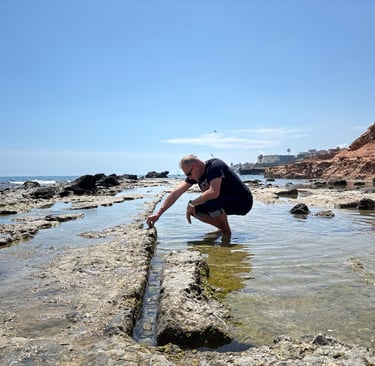Walking through time - reflections from an ancient shoreline
Have you ever stopped long enough to feel the story of a place — beyond the views, the weather, or the nature?
LIFESTYLE
Michal Wykowski
4/24/20252 min read


A few months ago, during a break from work, I had the rare opportunity to slow down, reflect, and explore. For several weeks, I spent my days walking along the sunny beaches and rugged hills of Costa Blanca and Murcia.
One moment that really stayed with me happened on the quiet beach of Mil Palmeras. In the shallow waters, I noticed neatly cut rocks rising from the sea. They looked like the remains of an ancient structure — and they were. I had stumbled upon the remains of a Roman quarry. A sign by the beach explained that it was used over 2,000 years ago to extract stone for construction.
It’s unlikely that this stone was transported to build major Roman cities like Ilice or Carthago Nova (present Elche & Cartagena) — the distance was too great, and the material wasn’t as refined as marble. More likely, these stones were used locally in nearby villas, such as those in Thiar, as the sign suggests. Though it may seem like an ordinary place, this quiet beach holds a story beneath the surface — a reminder that even simple places can carry deep history.
That moment made me pause and reflect:
Have you ever stopped long enough to feel the story of a place — beyond the views, the weather, or the nature?
Costa Blanca may be known for its sunshine and relaxed lifestyle, but it also carries the legacy of many civilizations. From the Bronze Age to the Romans, from the Moors to the medieval kingdoms, this region has been shaped by diverse cultures for thousands of years. Every ruin, castle wall, or ancient road holds a piece of that long story. Some sites here are even older than 50,000 years.
In future posts, I’ll take you through some of the places that inspired me — like Cartagena, Alicante, and a few lesser-known spots that reveal the historical heartbeat of Costa Blanca, hidden beneath the sunshine and sea breeze.
As we explore these stories, perhaps we’ll also find inspiration in how past civilizations shaped their world — and reflect on how we’re shaping our own. I still like to return to Mil Palmeras, as I did last week — not only to enjoy its beautiful beach but also to step on that old Roman quarry and feel connected to something much older than myself.
One powerful lesson from ancient Costa Blanca is the value of living in harmony with nature — something the Iberians and Romans practiced by choosing settlement locations carefully, based on geography and climate. While many cultures left their mark, the Romans arguably had the most lasting impact. They developed roads, expanded agriculture, and established trade routes that supported the region’s growth for centuries.
I can imagine the Romans building coastal villas with stunning views — much like we do today. Some still lie hidden in small towns across Costa Blanca. With all our technology, I wonder: what will remain of our world in 2,000 years?
Will we leave behind something worth rediscovering — or will our story quietly fade beneath the surface? Can we still find a way to live in better harmony with nature, as people once did long ago?
